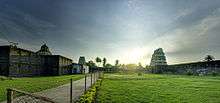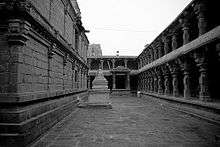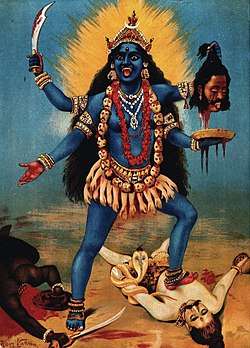Draksharama
| Daksharamam Dhakshatapovana, Dhakshavatika,Draksharama | |
|---|---|
| Town | |
| Country | India |
| State | Andhra Pradesh |
| District | East Godavari |
| Population (2011)[1] | |
| • Total | 9,299 |
| Languages | |
| • Official | Telugu |
| Time zone | UTC+5:30 (IST) |
| Vehicle registration | AP |


Draksharamam is a town in East Godavari district of the Indian state of Andhra Pradesh. The Bhimeswara Swamy temple in this town is one of the five powerful temples of Lord Siva, known as Pancharama Kshetras.The Manikyaamba temple in this town is one of the eighteen powerful temples of 18 Maha Shakti Pithas in India.
Etymology
The town was formerly known as Dhakshatapovana and Dhakshavatika.[2] This is the place where Daksha head of all prajapatis did a yagna or yajna called "Nireeswara yaga" or "Nireeswara yagna". This place's present name is a derivative of "Daksha aaraama" which means "Abode of Daksha". This place was also referred to as Daksha vaatika by Jagadguru Shankaracharya/ Adi Shankara in maha shakti peetha sloka at "Maanikye Daksha vaatika" which points to "Maanikyamba devi of Draksharama". The place where Daksha performed "Nireeswara yagna" is still visited by pilgrims here.
Legend
Daksha prajapati is son of Lord Brahma and grandson of Lord Vishnu. He rises to power and becomes the head of all prajapatis with the help of trimurtis(Brahma, Vishnu and Shiva). After rising to power and attaining powers from Creator, Preserver and Destroyers he starts getting arrogant. Daksha asks Chandra(Moon God) to marry his 27 adopted daughters (Stars Ashwini, Bharani,....). Chandra accepts the proposal and marries all 27 stars but loves Rohini a lot and neglects all other 26 stars. Due to his negligence remaining 26 daughters of Daksha goes to Daksha and complains about the bad behavior of Chandra. After getting furious by deeds of Chandra, Daksha gives him a curse to get infected by tuberculosis and die. Chandra goes to Lord Siva and begs his mercy. Siva being a kind god accepts his request and promises Chandra to save him. Daksha comes to Siva asking not to save Chandra. Siva rejects Daksha's appeal and tells him that he will not break his promise of saving Chandra. This makes Daksha angry on Shiva. Lord Vishnu then comes to rescue and makes Chandra undergo two transitions Sukla Paksha and Krishna Paksha. Chandra prays Siva to accept his living at Siva's feet. Siva lifts Chandra from the feet and places him on his head thus becoming "Chandra Mouleesawara". This ego spat between Siva and Daksha worsens meanwhile. Daksha wants his Daughter Sati to get married and announces Swayamvara in the thought of insulting Siva, Daksha keeps a statue of Shiva at the gate as a gate keeper. Sati choses that Siva statue as her husband. Siva comes and takes Sati with him to kailasa after marrying her. Daksha goes furious about this and grows enmity with Siva. After few years, Daksha announces yagna where he avoids inviting Siva and calls it "Nireeswara yagna". All devas warn him against the odds of not inviting and insulting Siva. Daksha gives them a cold shoulder and starts doing "Nireeswara Yagna".
After knowing that her father is doing a great sin, Dakshayani/Sati wants to stop his father from doing that. She asks Siva to permit her to attend the "Nireeswara Yagna" and stop it. Siva warns her not to go as they were not invited. Sati wants to go at any cost and Siva accepts her request about going there. Sati reaches Daksha vaatika, asks her mother and sisters to stop yagna but they don't speak to her. She goes to all invitees and asks them to stop the yagna but they won't help her. Finally she goes to her father and asks him to stop "Nireeswara yagna". Instead of stopping yagna Daksha starts abusing Siva and Sati humiliating her from every side. Due to the great insult happened to her and her husband Sati immolates herself at "Daksha aaraama".
Knowing about the immolation of Sati, Siva goes into deep pain and anger. He dances like a maniac in grief and anger. Then plucks one of his matted dread locks and hits it to the ground from which a great warrior emerges. Siva names him "Vira Bhadra" the one who gives safety with bravery and asks him to go to "Daksha aaraama" and kill everyone. Vira Bhadra goes to "Daksha aaraama" defeats everyone in the battle and beheads "Daksha". Later by the request of Daksha's wife, Siva makes Daksha live again by fixing goats head to his body. With great grief Siva lifts the body of Sati and starts dancing. To control Siva's grief Vishnu cuts Sati's body into 18 parts and those parts gets fallen at different places in India. The place where Sati's body parts were fallen are called Shakti Peetas. Here at Draksharamam Navel area of Sati devi was fallen hence the consort of Siva(Bheemeswara) was called "Maanikyaamba". Where Mani means navel in Sanksrit, goddess was named "Maanikyaamba". Thus becoming "Bheemeswara and Maanikyaamba" of Drakshaarama.
Aṣṭa Someśvara Temples
Initially the Lingam here was so intensely powerful that even the ṛiṣhis themselves were not able approach the Lord. As the lingam itself has a natural agni or fiery quality, the sapta ṛiṣhi’s installed seven lingams of a cooling nature associate with the moon. An eighth lingam was also installed by the Sūrya, the Sun God, to bring a soothing lunar energy over Bhimeśwara Swami, thus covering all eight directions and making him approachable.
The Saptaṛiṣhis and the Sun God were able to consecrate eight special Śiva Lingams with the cooling energy of moonlight in each of the eight directions surrounding Śrī Bhīmeśwara Swami. The Someśwara Lingams were placed in a network created by the great sages at distances ranging from 3 – 12 miles from Drākṣhārāmam. Each lingam is also associated various constellations and planets in the Vedic system of astrology. This location, layout and name of the ṛiṣhi that performed each installation is shown below.
To the Northeast, in Penumuru the Lingam has been installed by Jamadagni Mahāṛiṣhi. In the East, the pratiṣhṭa (installation) was carried out by Lord Sūrya in Kolanka. The Southeast Lingam was installed by Kaśyapa Mahāṛiṣhi in Dangeru Kṣhetram. North in Vella, Vaśiṣhṭa Mahāṛiṣhi installed the Lingam. The South Lingam was installed by Atri Mahāṛiṣhi in Koṭipalli. To the Northwest, in Someśwaram, the lingam was consecrated by Gautama Mahāṛiṣhi . The West Lingam was installed by Viśwamitra Mahāṛiṣhi in Vendūru. In the Southwest, the Lingam was installed by Bharadvaja Mahāṛiṣhi in Korūmilli.
Landmarks
Bheemeswara Swami temple is a big temple which was renovated by eastern chalukyas. Temple has a pushkarini called "Sapta godavari" where sapta rishis brought waters from seven different rivers to create it. One can find saptarishis in a small mantapa located in sapta godavari pushkarini. One can visit kashi viswesara temple constructed by vyasa and agasthyeswara swami who was worshiped by sage Agasthya. There are few mantapas available in the temple compound too. You can find four gopurams around the temple and few temples like kala bhairava, veera bhadra and vatuka bhairava temples inside the temple premises.
Festivals
Maha Siva Ratri and Dasara are the main festivals associated with Draksharama.
Transport
One can reach Draksharama by road, train and air.
Road: One can reach Rajahmundry and take a bus to Ramachandrapuram or One can reach Ravulapalem and take a bus to Ramachandrapuram. From Ramachandrapuram one should take Kotipalli or Yanam and other buses to reach Draksharama.
Train: One can reach Kakinada and take a train to Draksharama but there is only one rail bus running now and it won't run continuously.
Air: One can fly up to Rajahmundry and take a cab from airport to reach Draksharama in one and half hour.
See also
References
- ↑ "Census 2011". The Registrar General & Census Commissioner, India. Retrieved 26 July 2014.
- ↑ Moorthy, K. K. The aalayas of Andhra Pradesh: a sixteen-flower-garland. Message Publications.
External links
| Wikimedia Commons has media related to Draksharama. |
Coordinates: 16°47′34″N 82°03′49″E / 16.7928°N 82.0635°E

